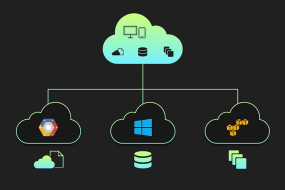
In today’s fast-paced digital landscape, businesses are increasingly relying on cloud infrastructure to meet their computing needs. However, as demand grows, so does the need for scalability. This brings us to a critical question: How can you effectively scale your cloud infrastructure without breaking the bank? In this comprehensive guide, we’ll delve into the intricacies of cost-effective scaling strategies to help you optimize your cloud infrastructure for maximum efficiency.
Understanding Scalability in Cloud Hosting
Before we dive into the strategies, let’s first grasp the concept of scalability in cloud hosting. Scalability is the ability of a system or application to handle an increasing workload without compromising performance. It ensures that your infrastructure can adapt seamlessly to changing demands, whether it’s a surge in website traffic or the need for additional processing power.
The Importance of Scalability
Scalability is not just a matter of convenience; it’s a business imperative. A lack of scalability can lead to downtime, slow response times, and frustrated users. On the other hand, a well-optimized and scalable cloud infrastructure empowers you to handle growth confidently, providing a seamless user experience even during peak periods.
Choosing the Right Cloud Service Model
Selecting the appropriate cloud service model sets the foundation for cost-effective scalability. Understanding the differences between Infrastructure as a Service (IaaS), Platform as a Service (PaaS), and Software as a Service (SaaS) is crucial in making an informed decision.
IaaS: Flexibility and Control
IaaS offers virtualized computing resources over the internet, providing a high degree of flexibility and control. It’s an excellent choice for businesses that require more customization and want to manage their own applications and data.
PaaS: Streamlined Development
PaaS provides a platform for developers to build, deploy, and manage applications without worrying about the underlying infrastructure. It streamlines the development process and allows for easy scaling as needed.
SaaS: Ready-Made Solutions
SaaS delivers software applications over the internet on a subscription basis. It’s a cost-effective option for businesses looking for ready-made solutions without the hassle of managing infrastructure.
Implementing Auto-Scaling Strategies
Auto-scaling is a game-changer in cloud infrastructure management. It allows your system to automatically adjust resources based on predefined criteria, ensuring optimal performance and cost efficiency.
Horizontal Scaling
Horizontal scaling involves adding more servers or instances to distribute the workload. This approach is particularly effective for web applications that can run in parallel.
Vertical Scaling
Vertical scaling, on the other hand, involves increasing the resources of a single server, such as upgrading CPU, RAM, or storage. While it can be costlier, it’s a viable solution for applications that require more processing power.
Trigger-Based Scaling
Trigger-based scaling enables you to set specific thresholds or events that trigger automatic adjustments in resources. For instance, you can scale up during high traffic periods and scale down during off-peak times.
Leveraging Serverless Architecture
Serverless computing allows you to focus on writing code without the need to manage servers. It’s a pay-per-use model, meaning you only pay for the time your code is executed. This approach can lead to significant cost savings, especially for sporadically used applications.
Optimizing Resource Utilization
Efficient resource utilization is at the heart of cost-effective scaling. By monitoring and fine-tuning your infrastructure, you can ensure that resources are allocated where they’re needed most.
Conducting Regular Performance Audits
Regular audits help identify bottlenecks, underutilized resources, and areas for improvement. Utilize monitoring tools to gain insights into your system’s performance.
Implementing Load Balancing
Load balancing evenly distributes incoming traffic across multiple servers, preventing any single server from becoming overwhelmed. This not only improves performance but also enhances reliability.
Final Words
In the ever-evolving digital landscape, optimizing your cloud infrastructure for efficiency is not just a cost-saving measure; it’s a strategic advantage. By understanding the principles of scalability, choosing the right service model, implementing auto-scaling strategies, and leveraging serverless architecture, you can ensure your cloud infrastructure is both robust and cost-effective.
Commonly Asked Questions
1. How can I determine if my application requires horizontal or vertical scaling?
Determining the scaling approach depends on your application’s architecture and requirements. Horizontal scaling is suitable for applications that can run concurrently across multiple servers, while vertical scaling is ideal for those with specific resource-intensive tasks.
2. What are the key benefits of serverless computing for cost-effective scaling?
Serverless computing eliminates the need to provision and manage servers, leading to significant cost savings. You only pay for the actual execution time of your code, making it an efficient solution for sporadically used applications.
3. How can I ensure that my auto-scaling triggers are set optimally?
Optimal trigger settings are based on thorough performance monitoring and analysis. Start by identifying peak usage periods and set triggers to accommodate those peaks while avoiding unnecessary resource allocation during off-peak times.
4. What are some recommended monitoring tools for cloud infrastructure?
Popular monitoring tools like AWS CloudWatch, Google Cloud Monitoring, and Azure Monitor provide comprehensive insights into your cloud infrastructure’s performance. They allow you to track metrics, set alarms, and gain valuable data for optimization.
5. How often should I conduct performance audits for my cloud infrastructure?
Regular performance audits are essential for staying ahead of potential issues. Aim to conduct audits at least quarterly, and more frequently during periods of significant growth or change in usage patterns.
Advertisement







